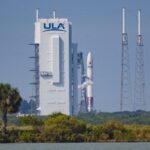The Japanese space agency JAXA has released the first test images from its X-Ray Imaging and Spectroscopy Mission (XRISM). The images show a galaxy cluster and a supernova remnant, and offer insight into the chemical cocktail that composes the supernova.
An X-ray telescope functions similarly to the X-ray Specs of your favorite comic books: they reveal aspects of the cosmos that would otherwise be invisible, enabling astronomers to peer at the undercarriage of the cosmos.
XRISM launched in September 2023. It is designed to detect X-rays with energies from 400 electron volts to 12,000 electron volts (visible light—the kind the human eye can see—is just 2-3 electron volts). XRISM’s powerful gaze will be trained on some of the hottest venues in the universe, like explosive deaths of stars and black holes. Basically, anything that emits a lot of high-energy X-rays. XRISM is a collaboration between JAXA and NASA, with participation from the European Space Agency (ESA will get 8% of XRISM’s observing time).
The galaxy cluster XRISM used for the test imagery is Abell 2319, a 3-million-light-year-wide group of galaxies that is clouded by million-degree X-ray-emitting gases. Studying the gas helps astronomers calculate the cluster’s total mass, in turn yielding insights about how the universe evolved, according to an ESA release.

These rays were imaged by XRISM’s Xtend instrument, and overlaid onto images by ground-based telescopes to put the X-ray light in cosmic context. Xtend uses a CCD camera to image a wide field of X-rays. Because of this large field, researchers hope that the instrument will more easily clue scientists into the large-scale structures in the universe.
XRISM’s other image was of the supernova remnant N132, which sits in the Large Magellanic Cloud, about 160,000 light-years away. N132 is thought to be about 3,000 years old. It is the colorful remnant of a star about 15 times the mass of the Sun, which died when it ran out of fuel, collapsed, and then violently exploded.
The satellite’s Resolve instrument—a microcalorimeter spectrometer, operating just above absolute zero—shows the chemical composition of the supernova, which are associated with the elements silicon, sulfur, calcium, argon, and iron. According to a NASA release, the Resolve data is the most detailed X-ray spectrum of the supernova yet obtained.
Regular operations of XRISM will begin later this year, but the test images show what is in store for the satellite—and, of course, our understanding of the X-ray universe.








